Arizona, a land imbued with natural beauty and rich biodiversity, serves as a grand stage for a striking variety of Birds of Prey (37 species, to be precise but we are just focusing on the most common 23).
Soaring high above the vast desert landscapes and sweeping canyons, these magnificent creatures truly epitomize the wild spirit of the state. Be it the keen-eyed hawks circling in the brilliant blue sky, the stealthy owls silently stalking their prey in the twilight, or the majestic eagles, their wings casting enormous shadows over the sun-baked terrain, each species brings a unique dimension to Arizona’s vibrant ecosystem.
List of Birds of Prey in Arizona:
Hawks: Red-tailed Hawk, Cooper’s Hawk, Harris’s Hawk, Swainson’s Hawk, Zone-tailed Hawk, Ferruginous Hawk, Broad-winged Hawk, Rough legged hawk, Gray Hawk, Sharp shinned hawk
Eagles: Bald Eagle, Golden Eagle
Falcons: Peregrine Falcon, American Kestrel, Merlin, Prairie Falcon
Owls: Great Horned Owl, Burrowing Owl, Barn Owl , Western Screech-Owl , Northern Pygmy-Owl, Elf Owl, Long-eared Owl, Short-eared Owl
Red-tailed Hawk (Buteo jamaicensis)

The Red-tailed Hawk is a large bird of prey that is commonly found across North America. This species is part of the genus Buteo, which is often referred to as the “true hawks,” and includes more than two dozen species of raptors.
Red-tailed Hawks have a robust size, ranging from 18 to 26 inches in length and sporting a wingspan that can exceed 4 feet. They have a broad, rounded set of wings and a short, wide red tail. This species is most easily recognized by its rich, rust-colored tail, which gives it its common name. However, juvenile hawks might not yet have this distinctive feature.
Their feathers are generally dark brown on their dorsal side (back) with a lighter, often speckled, ventral side (front). The intensity and pattern of their plumage can vary significantly based on their age and geographic location, as there are about 14 recognized subspecies of Red-tailed Hawks.
As for their diet, Red-tailed Hawks are carnivores and have a broad diet that includes rodents, ground rabbits, reptiles, and other birds. They are skilled hunters that typically sit on high perches and use their keen eyesight to spot potential prey. Once they have identified a target, they swoop down to capture it with their powerful talons.
Red-tailed Hawks mate for life and build nests high off the ground, often in tall trees or on cliff edges. Their nests are made of sticks and can be quite large. They typically lay 1-3 eggs per year, which are incubated by both parents.

Red-tailed Hawk Sound
Cooper’s Hawk (Accipiter cooperii)
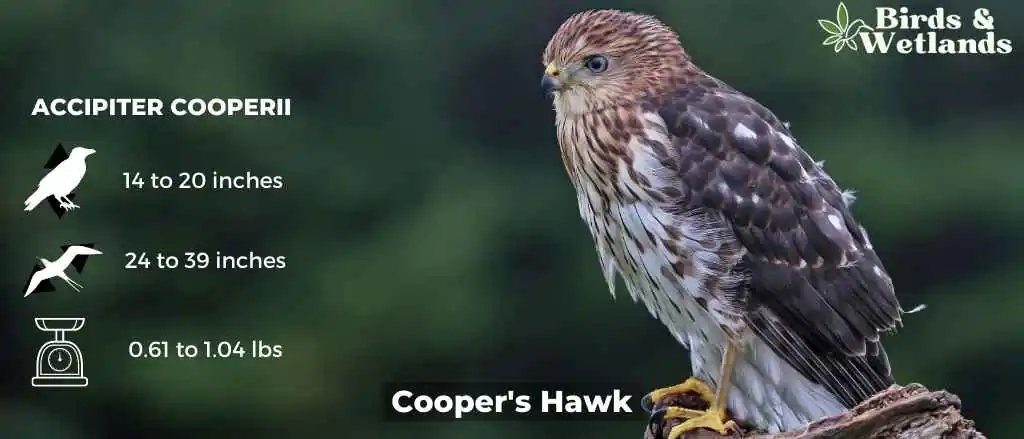
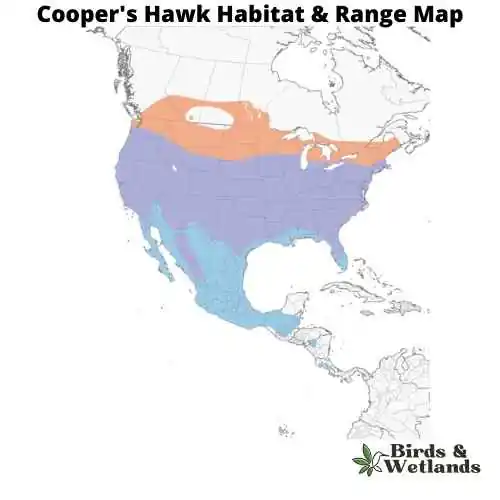
Listen:
The Cooper’s Hawk is a medium-sized bird of prey native to North America. Known for its agility and speed, it is part of the Accipitridae hawk species, which also includes other hawks, eagles, and kites.
Cooper’s Hawks are typically about 14 to 20 inches in length, with a wingspan ranging from 27 to 36 inches. They are known for their distinctive long, rounded tails and short, rounded wings. They have a steely blue gray top, with rusty bars on their underparts and thick, dark bands on their tails.
The Cooper’s Hawk is a skilled predator, primarily hunting birds and small mammals. They are adept at hunting in both dense forests and open areas, often catching prey mid-air in high-speed pursuits. They have also been known to visit the backyard bird feeder, not for the seed, but to prey on the smaller birds that gather there.
Cooper’s Hawks often build nests in dense tree canopies where they are well concealed. The female usually lays 3 to 5 eggs, and both parents share incubation duties. The young hawks fledge after about a month but will stay close to the nest, relying on their parents for food as they learn to hunt.

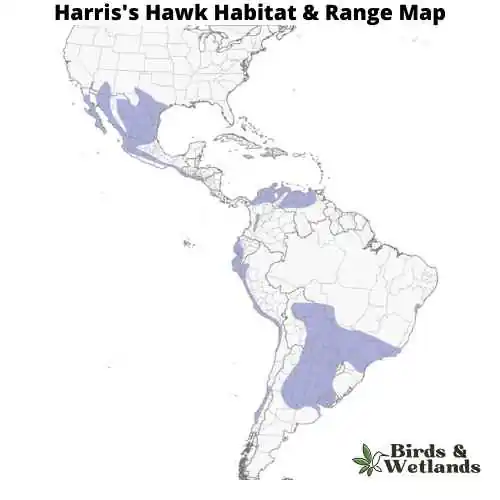
Harris’s Hawk Sound
Scientific Name: Parabuteo unicinctus
Length: 18 to 23 in
Wingspan: 41 to 47 in
Weight: 1.2 to 3.6 lb
The Harris’s Hawk is a unique bird of prey, recognized by its distinct social behavior and richly colored plumage. This raptor prefers semi-arid habitats like desert scrub, woodlands, and savannas.
Harris’s Hawk sports a dark brown or chestnut-brown body, with striking reddish-brown shoulders and legs. A characteristic feature of this bird is its white-tipped tail, along with a white band on the underside of its tail feathers.
Harris’s Hawks diet mainly consists of small mammals, birds, and lizards. One of the unique behavioral traits of this species is that it often hunts cooperatively in groups, a rarity among raptors. This group hunting strategy often involves surrounding and flushing out prey, or taking turns chasing it, which increases the likelihood of a successful hunt. Harris’s Hawk also engage in “stacking,” where they perch on top of each other, which is a behavior rarely seen in birds of prey.
Nesting for Harris’s Hawks involves the building of a platform of sticks in a tree or cactus, where the female usually lays 2 to 4 eggs. Both parents share in the incubation and rearing of the chicks, with sometimes even older offspring assisting in the process.
Swainson’s Hawk (Buteo swainsoni)

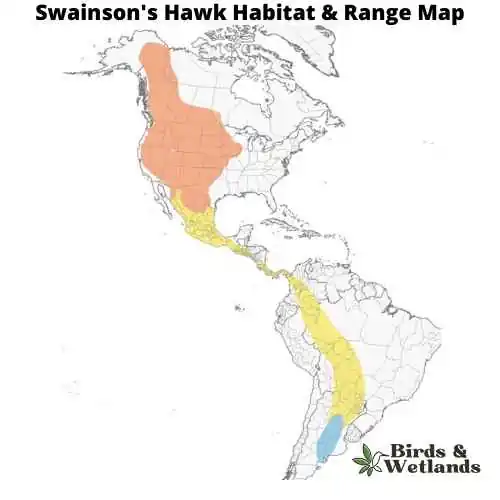
Listen: Swainson’s Hawk
Swainson’s Hawk is a medium-sized hawk that is found in North America and South America, Scientific Name: Buteo swainsoni.
The bird has a blue-gray plumage with a dark brown back, wings, and tail. It also has a white chest and belly. The beak and feet are black, but the eyes are yellow. They are often confused with Cooper’s Hawk because of similar coloring, but Swainson’s Hawks have wider tails and longer wings than their cousin species.
These birds eat small rodents such as gophers and mice. They also eat insects like grasshoppers and crickets during the summer months when they’re plentiful. They sometimes steal prey from other birds of prey such as Northern Harriers who hunt the same prey.
Swainson’s Hawks build nests on rocky cliffs near water sources where they can find food easily. They lay three to five eggs that hatch after about two months into fluffy brown baby hawks who leave the nest after about three weeks (or when they’re big enough).
Zone-tailed Hawk (Buteo albonotatus)

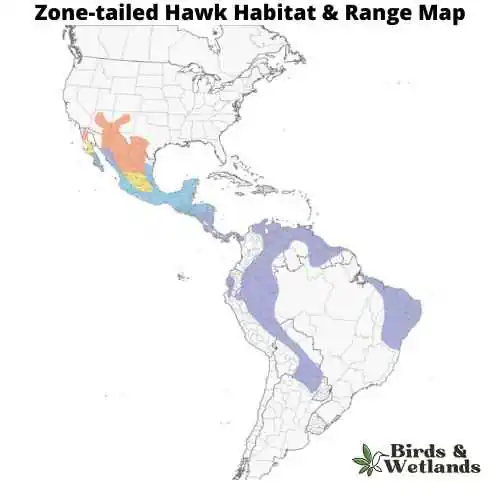
Zone-tailed Hawk Sound
Scientific Name: Buteo albonotatus
Length: 18 to 22 in
Wingspan: 46 to 55 in
Weight: 1.2 to 2 lb
The Zone-tailed Hawk, or Buteo albonotatus, is a medium-sized bird of prey known for its unique appearance and behavior that mimics turkey vultures, a strategy used to deceive prey. This raptor is primarily found in the warmer regions of the Americas, including the southwestern United States, Mexico, and down to Argentina.
The Zone-tailed Hawks body are predominantly black, with white bands, or “zones,” on the tail, which give the bird its name. From a distance, the Zone-tailed Hawk can easily be mistaken for a turkey vulture due to its similar coloration and flight pattern.
Zone-tailed Hawk feeds on small mammals, birds, and reptiles. Its hunting strategy is particularly clever. By mimicking the less-threatening turkey vulture in flight, it can often approach prey unnoticed before launching a surprise attack.
Nesting typically takes place in trees, cliffs, or even on man-made structures. The female lays 1 to 3 eggs, and both parents share incubation and feeding duties.
Ferruginous Hawk (Buteo regalis)

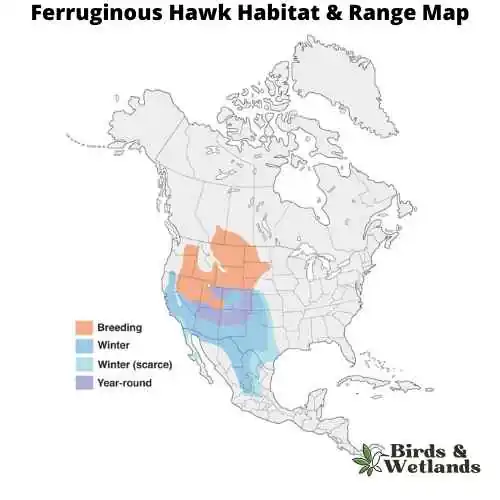
Ferruginous Hawk Sound
Scientific Name: Buteo regalis
Length: 20 to 27 in
Wingspan: 48 to 60 in
Weight: 32.0 to 80.0 oz
The Ferruginous Hawkis the largest hawk species native to North America. Known for its distinctive coloration and impressive size, this bird of prey predominantly inhabits the open landscapes of the western United States and parts of Canada.
Ferruginous Hawks are notable for their “ferruginous” or rust-colored back and shoulders, which contrasts sharply with the bird’s white underside. The hawk also has broad, rounded wings and a large, gape-mouthed beak. Ferruginous hawks exhibit dark morph and light morphs. Dark morphs have dark brown plumage, while light morphs display lighter, reddish-brown plumage. Morphs vary geographically.
Primarily feeding on small to medium sized mammals like rabbits and prairie dogs, the Ferruginous Hawk is an agile hunter, often seen soaring high above the ground or perched prominently while scanning for prey. It occasionally feeds on birds, reptiles, and insects as well.
Nesting for Ferruginous Hawks typically occurs on cliffs, hillsides, or large trees. The female lays between 2 to 5 eggs, and both parents share in the incubation and rearing of the chicks. The Ferruginous Hawk is a relatively solitary bird outside of the breeding season, and its call is a loud, high-pitched scream, often heard during courtship or near the nest.
Broad-winged Hawk (Buteo platypterus)

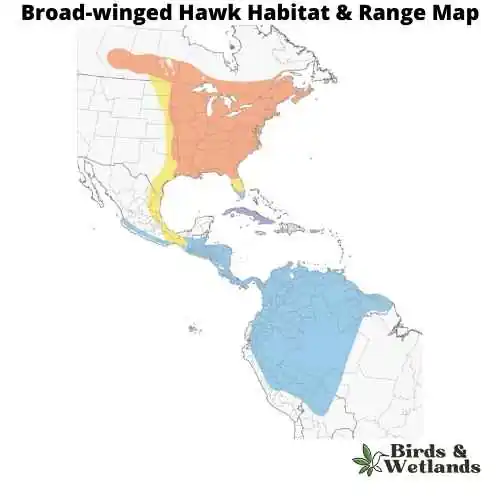
Broad-winged Hawk Sound
The Broad-winged Hawk holds a commanding presence as one of the largest hawks in the world, known for its broad wings. Its formidable size is a testament to its prowess as a bird of prey, effortlessly navigating the open skies in search of food.
Their distinctive appearance sets them apart. The adults exhibit a striking black and white pattern, complemented by a rusty breast and buff underparts and brown wings. In contrast, juveniles are adorned with a brown plumage, marked by pale edges on their feathers, adding to their distinctive youthful charm.
These hawks are most commonly found in open areas, such as farmlands or grasslands interspersed with scattered trees, which provide optimal conditions for when hawks hunt.
When it comes to their diet, Broad-winged Hawks feed on small rodents like mice, rats, squirrels, rabbits, and voles. Broad winged hawks breed during the spring and summer months then migrate to central and south America.
Rough-legged Hawk (Buteo lagopus)

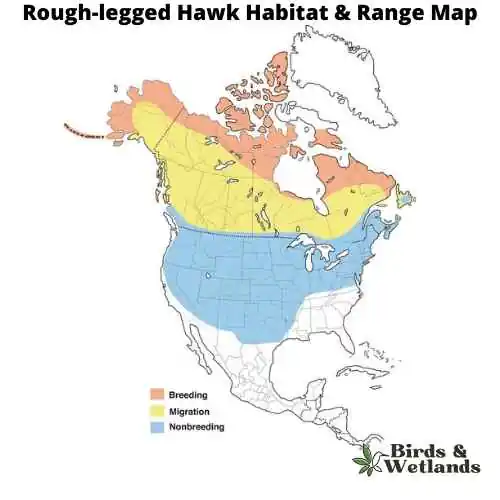
Rough-legged Hawk Sound
The Rough-legged Hawk is a large, raptor that is native to North America. It is also known as the American Rough-legged Hawk. Scientific Name: Buteo lagopus
The Rough-legged Hawk is a medium-sized hawk with a distinctive appearance, with dark brown feathers on its back and light brown feathers on its underside and broad thin wings. The hawk’s legs are also covered in dark feathers, which help to distinguish it from other species of hawk. The tail is barred with black and white. They have yellow eyes and dark feet.
Rough-legged Hawks hunt from above ground level, swooping down to catch its prey in its talons. When hunting for food, they prefer to eat small mammals such as squirrels and rabbits but will also eat birds if there aren’t any small mammals available. Although they eat a variety of small animals including birds, rodents, bats and reptiles, they rely heavily on fish for food during breeding season because it provides them with protein and calcium needed to produce eggs.
Gray Hawk (Buteo plagiatus)


Gray Hawk Sound
Scientific Name: Buteo plagiatus
Length: 18–24 in
Wingspan: 82-98 cm
Weight: 16.8 oz
The Gray Hawk is a small bird of prey native to the Americas. Known for its distinct coloration and elegant flight, this raptor is found in both the southwestern United States and across Central and South America.
Gray Hawks plumage is characterized by a light gray body, contrasted with a darker gray back and wings. Its tail features broad white and gray bands, making it a distinctive feature.
Primarily hunting from a perch, the Gray Hawk feeds mainly on small mammals, birds, and reptiles, including lizards and snakes. It often patrols the edges of clearings, diving swiftly to catch prey off guard.
Nesting for the Gray Hawk typically occurs in trees. The female usually lays 1 to 3 eggs, and both parents share in incubation duties. The nestlings are generally dependent on the parents for food for a few weeks after hatching.
The Gray Hawk’s call is a high-pitched, plaintive scream, which is often repeated several times. The species is primarily a solitary bird, usually seen alone or in pairs.
Bald Eagle (Haliaeetus leucocephalus)

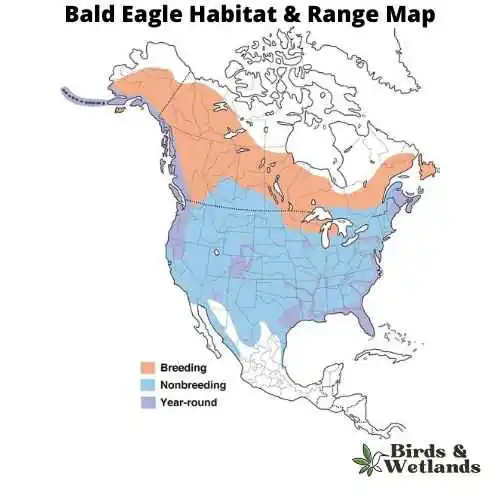
Bald Eagle Sound
Scientific Name: Haliaeetus leucocephalus
Length: 28–40 in
Wingspan: 5 ft 11 in and 7 ft 7 in
Weight: 6.6 -13.9 lb
The Bald Eagle, primarily found in Canada and Alaska, is instantly identifiable by its white head, dark brown body, yellow beak, and a piercing cry. Its sharp, orange-yellow eyes aid in efficient night hunting.
Predominantly residing in North America, occasionally venturing into Asia and Europe, it thrives near water bodies. It perches atop trees, providing a bird’s-eye view of its prey. It feeds on fish, carrion, small mammals like rabbits and squirrels, and reptiles. Hunting involves a swift downward swoop to seize the prey, carrying it back to the nest.
Bald Eagles are monogamous, forming lifelong pairings. They construct vast nests from sticks, lined with moss or grasses. They typically lay 1-3 eggs annually, which hatch around 35 days later. The fledglings leave the nest roughly 6 weeks after hatching, but continue to rely on their parents for nourishment for a further 5-6 months, until they become proficient hunters.
Golden Eagle (Aquila chrysaetos)


Golden Eagle Sound
Scientific Name:Aquila chrysaetos
Length: 26 to 40 in
Wingspan: 5 ft 11 in to 7 ft 8 in
Weight: 8.9 and 14.0 lb
The Golden Eagle is a large bird of prey known for its strength, speed, and hunting prowess.
Adult Golden Eagles are large birds, and are named for the golden-brown plumage on their heads and necks, which contrasts with their darker brown body feathers. Their eyes, legs, and bill are all yellow.
These eagles prefer open, rugged terrain, including mountains, hills, grasslands, and deserts. They are most often found in areas that provide good opportunities for soaring and hunting.
Golden Eagles have a varied diet but primarily prey on small to medium-sized mammals such as rabbits, hares, and ground squirrels. They are also capable of taking larger prey, like young deer or livestock, but these are not typically part of their diet.
Golden Eagles build large nests or eyries, usually on cliffs or in tall trees. The nests are often reused and added to each year, becoming enormous structures over time. The female typically lays 1 to 4 eggs, which both parents incubate.
Peregrine Falcon (Falco peregrinus)


Peregrine Falcon Sound
Scientific Name: Falco peregrinus
Length: 14.2-19.3 in
Wingspan: 39.4-43.3 in
Weight: 530-1600 g
Known for its blue-gray plumage and unique cheek bars, the Peregrine Falcon stands as a beacon of power and swiftness. Despite its modest size, it reigns as the world’s fastest creature, reaching staggering speeds up to 240 mph during hunting dives.
Its diet mainly includes birds, occasionally bats, caught in an enthralling aerial display of agility and precision. Adapting to diverse habitats, this bird graces every continent except Antarctica, finding home in environments from city skyscrapers to towering cliffs.
Peregrine Falcons, monogamous in nature, often pair for life, expressing their bonds through complex courtship flights filled with intricate aerial maneuvers. They construct simple scrape nests on high ledges, often without adding materials.
Their parenting duties are shared, from egg incubation to feeding and caring for the chicks, ensuring their offspring are ready to take on the skies in their own time.
American Kestrel (Falco sparverius)


American Kestrel Sound
Scientific Name: Falco sparverius
Length: 8.7 to 12.2 in
Wingspan: 20–24 in
Weight: 3.0–5.8 oz
The American Kestrel, often recognized as the smallest and most brightly colored falcon in North America, exhibits a stunning array of rufous, blue and gray hues in its plumage. This bird, ranging in size from a mere 22 to 31 cm, carries distinct black facial markings that contrast with its white cheeks and has blue gray wings. Despite its small stature, the American Kestrel is a formidable predator, employing a unique hunting strategy that involves hovering at a height before swooping down on prey, primarily consisting of insects, small mammals, and occasionally small birds.
Residing predominantly in North and South America, the American Kestrel exhibits a preference for open habitats such as meadows, grasslands, and deserts. They are also found in both urban and suburban environments, nesting in cavities in trees, cliffs, buildings, and other structures. Kestrels are monogamous, with both sexes participating in the courtship displays that involve aerial acrobatics and feeding rituals. Nesting duties are a shared responsibility, with the male initially scouting for suitable locations and the female making the final selection. Both parents contribute to the incubation of the eggs and care of the young, ensuring the perpetuation of this captivating species.
Merlin (Falco columbarius)


Merlin Sound
Scientific Name: Falco columbarius
Length: 9.4–13.0 in
Wingspan: 20–29 in
Weight: 5.8 – 8.1 ozz
The Merlin is a small, robust falcon known for its blue-gray or dark brown upperparts and thinly streaked, buff to orange underparts. Unlike other falcons, it has faint facial markings, offering a more uniform look.
This compact bird, renowned for its hunting prowess, chases down small birds in mid-air, exemplifying its impressive speed and agility.
Residing across northern North America, Europe, and Asia, the Merlin prefers open or semi-open landscapes. Rather than constructing their own nests, they tend to reuse old crow or raptor nests, or choose to nest on the ground in open habitats.
During courtship, males perform elaborate aerial displays. Both parents share egg incubation duties, with the male also responsible for feeding the family, reflecting the Merlin’s fascinating role in the biodiversity of its ecosystems.
Prairie Falcon (Falco mexicanus)
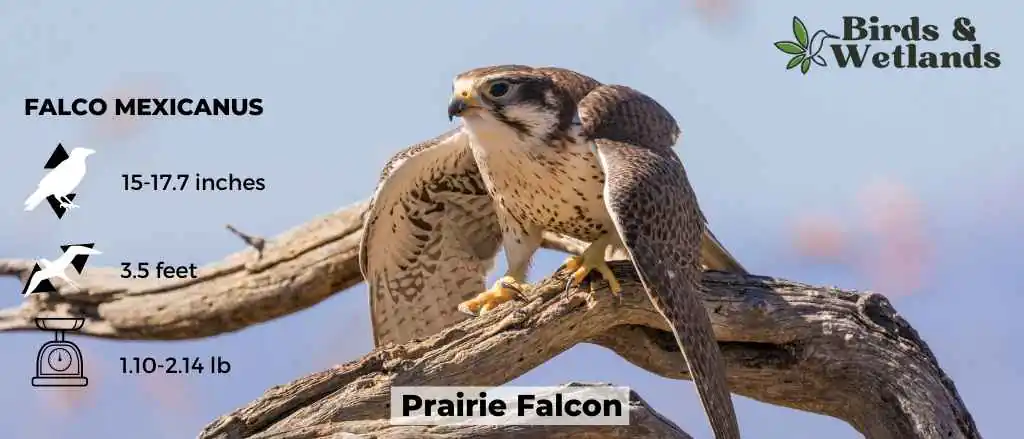

Prairie Falcon Sound
Scientific Name: Falco mexicanus
Length: 15 in – 17.7 in
Wingspan: 3.5 feet
Weight: 1.1 to 2.1 lbs
The Prairie Falcon, is a large falcon species that inhabits the open landscapes of North America, particularly in the western regions of the continent. Known for its agility and speed, this bird of prey is a skilled hunter and a master of flight.
Prairie Falcons sport a distinct color pattern with a pale, buffy brown body, contrasted with darker wingtips and a characteristic “mustache” mark near the eyes, a feature common to many falcons.
The Prairie Falcon’s diet primarily consists of small mammals and birds. It is known for its high-speed aerial pursuits, diving onto its prey from great heights. This agile predator often utilizes the open terrain of its habitat, making swift, low-level flights to catch prey off-guard.
Nesting for the Prairie Falcon often takes place on high cliff ledges, where it lays a clutch of 3 to 5 eggs. After hatching, the young falcons remain in the nest for up to six weeks, continuing to rely on their parents for food until they master hunting skills.
Great Horned Owl (Bubo virginianus)
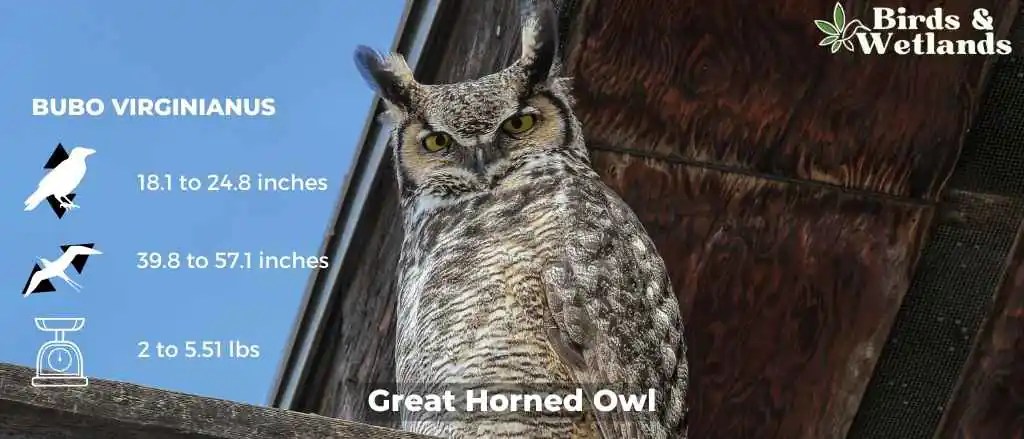

Great Horned Owl Sound
Scientific Name:Bubo virginianus
Length: 18.1-24.8 in
Wingspan: 39.8-57.1 in
Weight: 32.1-88.2 oz
The Great Horned Owl is a large owl with long wings and a large head. It’s one of the most common owls in North America.
Great Horned Owls are large, stocky birds with soft feathers that are gray to brown on their backs and white on their chests. Their faces are characterized by two black “ear” tufts, which can be raised or flattened depending on the owl’s mood. The eyes are yellow, orange, or red in color.
The habitat of the Great Horned Owl is a variety of different environments such as forests and deserts. They also live near water sources such as lakes, streams and rivers where they can hunt for fish.
The diet of the Great Horned Owl consists primarily of small mammals such as mice and rats; however they will also eat other rodents such as squirrels, rabbits and porcupines. They have been known to eat skunks too.
Burrowing Owl (Athene cunicularia)


Burrowing Owl Sound
Scientific Name: Athene cunicularia
Length: 7–11 in
Wingspan: 20–24 in
Weight:5–8 oz
The Burrowing Owl is a small, long-legged species of owl found in North and South America. Known for its unusual habit of living in burrows in the ground.
Burrowing Owls have a rounded head with no ear tufts and bright yellow eyes. Their overall coloration is mottled brown and white with a distinct white “eyebrow” above each eye.
Their primary habitat includes open landscapes such as grasslands, deserts, agricultural areas, golf courses, and even airports. As their name suggests, these owls often reside in burrows, many of which are abandoned by prairie dogs, ground squirrels, or other burrowing animals. In some cases, they may also dig their own burrows.
Burrowing Owls diet consists mainly of small mammals and insects, but they also eat birds and reptiles.
Burrowing Owls have a unique nesting behavior. They lay their eggs in an underground burrow to protect them from predators and extreme weather. Clutch sizes range from 6 to 11 eggs, which are incubated for about a month before hatching.
Barn Owl (Tyto alba)

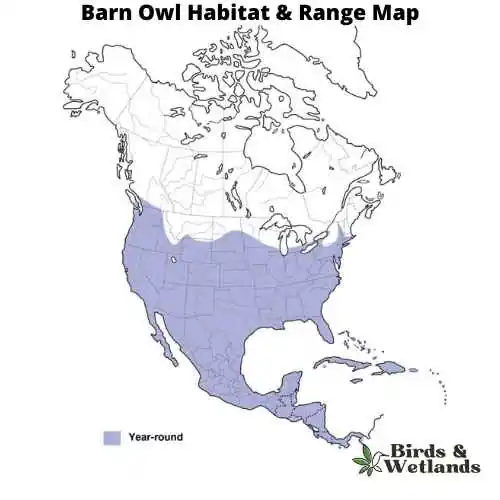
Barn Owl Sound
Scientific Name: Tyto alba
Length: 13 to 15 in
Wingspan: 31 to 37 in
Weight: 9.2 oz
The Barn Owl is a widespread species of owl known for its distinctive heart-shaped facial disc.
Barn Owls are medium-sized owls, they are pale overall with golden-brown wings and back, contrasted by a white face, chest, and belly. Their most notable feature is their heart-shaped facial disc, which helps channel sound to their ears.
Barn Owls are typically found in open habitats, including farmland, woodland, and marshes. They are named for their habit of nesting in human structures such as barns, church towers, and in the hollows of large trees. These owls are nocturnal, hunting at night and roosting during the day.
The diet of Barn Owls primarily consists of small mammals, particularly rodents such as mice and rats. They are known for their silent flight, which allows them to sneak up on their prey without detection.
Barn Owls have a unique nesting behavior. They do not build nests, but instead, lay their eggs directly on the bare surface of a secluded ledge or cavity. A female typically lays 4-7 eggs, and both parents help incubate the eggs and care for the chicks.
Western Screech-Owl (Western Screech-Owl)

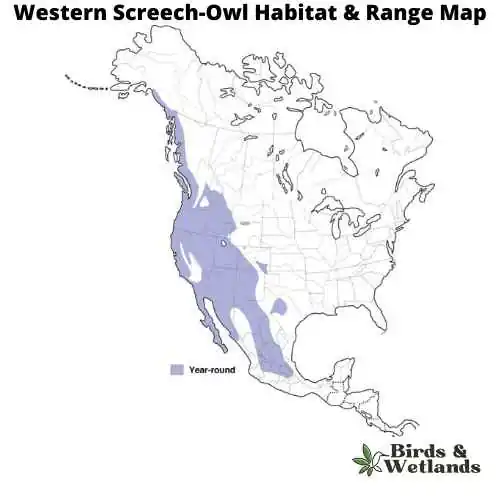
Western Screech-Owl Sound
Scientific Name: Megascops kennicottii
Length: 22 cm (8.7 in)
Wingspan: 55 cm (22 in)n
Weight: 88 to 220 g (3.1 to 7.8 oz)
The Western Screech-Owl, or Megascops kennicottii, is a small species of owl native to North and Central America. Western Screech-Owls are nocturnal predators, and its diet primarily consists of small mammals, birds, insects, and occasionally fish.
This owl is medium-sized compared to other screech-owls. It has a compact, stocky body, and is often recognized by its large head with yellow eyes surrounded by greyish-brown facial disks. The plumage is generally a mixture of grey and brown, with intricate patterns of spots and streaks that provide excellent camouflage against tree bark.
These owls prefer mixed woodland habitats, including deciduous forests and semi-open areas with trees. They often nest in tree cavities, but will also readily take to nest boxes if available. These birds are primarily non-migratory, and once they’ve established a territory, they tend to stay within the same area year-round.
Northern Pygmy-Owl (Glaucidium gnoma)


Northern Pygmy-Owl Sound
Scientific Name: Glaucidium gnoma
Length: 7 – 7 1/2 in)
Wingspan: 14.5 – 16 in
Weight: 62-73g
The Northern Pygmy-Owl is a small owl species native to North and Central America. Despite its small size, this owl is a fierce predator, known for its distinctive call and daytime hunting habits.
They have a rounded head without ear tufts and large yellow eyes. Their overall coloration is gray or brown with a pattern of white spots on the back and streaks on the front.
Northern Pygmy-Owls inhabit a range of habitats, including coniferous forests, deciduous woodlands, and mixed forests. They can be found at a range of elevations from lowlands to mountains. Unlike many other owl species, they are often active during the day, particularly in the early morning and late afternoon.
Their diet primarily consists of small mammals and birds, but they are also known to eat insects and reptiles. Despite their small size, they have been known to take prey up to three times their own size.
Northern Pygmy-Owls nest in tree cavities, often those created by woodpeckers. They do not build nests of their own but will add a few feathers to the cavity. Clutch size is usually around 2 to 7 eggs, which are incubated by the female while the male brings food.
Elf Owl


Elf Owl Sound
Scientific Name: Micrathene whitneyi
Length: 4.9 to 5.7 in
Wingspan: 10.5 in
Weight: 1.4 oz
The Elf Owl is a small species of owl that inhabits the southwestern regions of the United States and Mexico. It holds the distinction of being one of the smallest owl species in the world.
Elf Owls are tiny, they have a round head with no ear tufts, large yellow eyes, and a pale gray-brown body with a lightly spotted or streaked pattern.
The primary habitat for Elf Owls includes desert and woodland areas. They are especially fond of regions with saguaro cacti or other types of cavities in trees, which they use for nesting. They are nocturnal creatures, with most of their activity occurring after dusk.
Elf Owls feed primarily on a diet of insects and other small invertebrates. Occasionally, they may also eat small mammals and birds. They are known for their agile flight and keen hunting skills, often catching insects in midair.
When it comes to nesting, Elf Owls take advantage of the natural cavities in trees or cacti, where they lay a clutch of 2 to 4 eggs. The female is responsible for incubation, which lasts about three weeks, while the male provides food.
The long-eared owl (Asio otus)
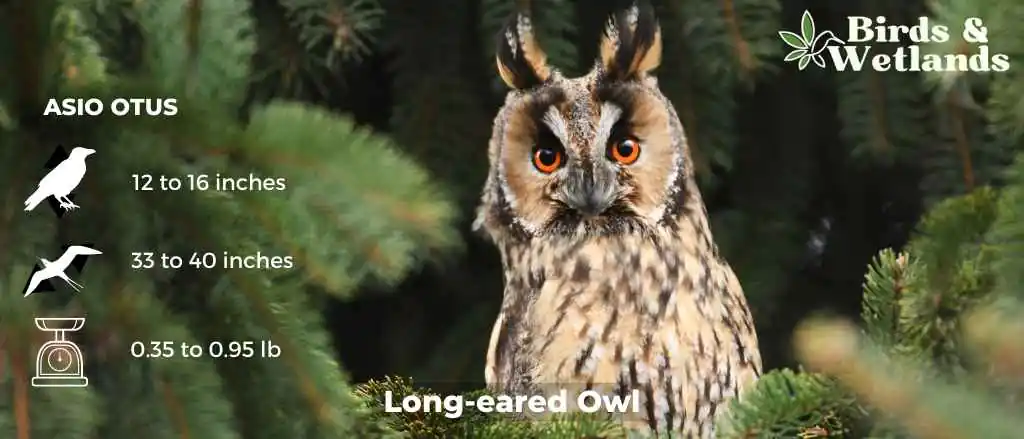

Long-eared Owl Sound
Scientific Name: Asio otus
Length: 12 and 16 in
Wingspan: 2 ft 10 in to 3 ft 4 in
Weight: 5.6 to 15.3 oz
The Long-eared Owl is a medium-sized owl species known for its distinctively long ear tufts, which can be raised or lowered depending on the bird’s mood or intention.
Long-eared Owls have mottled brown and cream plumage, which provides excellent camouflage among the trees. Their most distinctive features are their long, black-tipped ear tufts, which are set closer to the center of the head than in most other owl species.
These owls inhabit a wide variety of habitats, including deciduous and coniferous forests, woodlands, and even semi-deserts.
The Long-eared Owl’s diet primarily consists of small mammals, especially voles, but they will also take small birds and insects. They are skillful hunters, often capturing prey from a perch or in flight.
In terms of nesting behavior, Long-eared Owls do not construct their own nests, instead they take over old nests built by other bird species, usually those of corvids or other large birds. They lay an average of 4 to 5 eggs, which are incubated by the female while the male provides food.
Short-eared Owl (Asio flammeus)
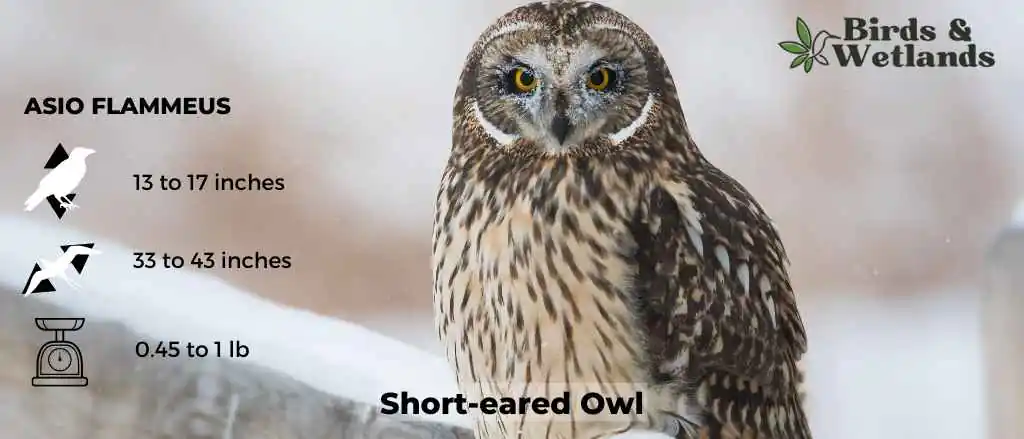
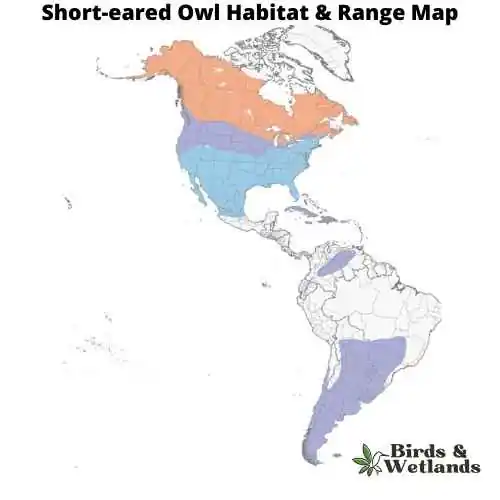
Short-eared Owl Sound
Scientific Name: Asio flammeus
Length: 13–17 in
Wingspan: 33 to 43 in
Weight: 7.3–16.8 oz
The Short-eared Owl is a medium-sized owl species with a wide distribution, found across North and South America, Europe, Asia, and many Pacific islands. Despite its name, the “ears” of the Short-eared Owl are not often visible, as they are small and tend to blend with the bird’s feathers.
The owls are predominantly brown with buff and white accents throughout their body and wings, and dark patches around their yellow eyes.
Short-eared Owls diet consists largely of small mammals, especially voles. However, they are opportunistic hunters and will also prey on a variety of other animals, including other birds, when available.
Their habitat is characterized by open areas like grasslands, marshes, and tundra. They nest on the ground, which is unusual for owls, and this makes them vulnerable to ground predators. As such, they often live in areas with tall grasses or other ground cover for protection.
Top Bird-Watching Spots:
- Saguaro National Park: This park is an excellent place to spot a variety of Birds of Prey in Arizona. From Harris’s Hawks to Great Horned Owls, the park’s diverse habitats provide plenty of opportunities for bird watchers to spot these captivating creatures.
- Grand Canyon National Park: Known for its breathtaking vistas, the park is also a bird watcher’s paradise. Birds such as the California Condor and Peregrine Falcon often grace the skies above the canyon, offering memorable sightings.
- Kofa National Wildlife Refuge: Located in the heart of Arizona’s desert, this refuge is home to a number of raptors, including the Golden Eagle and the American Kestrel. The stark desert landscapes provide a dramatic backdrop for observing these majestic birds.
Consider broadening your ornithological adventure to the neighboring states, each showcasing a unique blend of avian wonders. Take a virtual flight over to New Mexico to see the preying birds, where similar arid landscapes play host to an array of raptors. As you traverse northward, you’ll discover the Rocky Mountain highs of Colorado, teeming with soaring raptors – eagles and falcons that thrive in the state’s alpine environments.
Alternatively, the verdant expanses and Great Basin deserts of Utah birds of prey and birds of prey of Nevada respectively offer yet more distinct habitats and their associated raptor populations. For a more encompassing view, our master guide to Birds of Prey in USA will knit together this grand tapestry of avian diversity.

